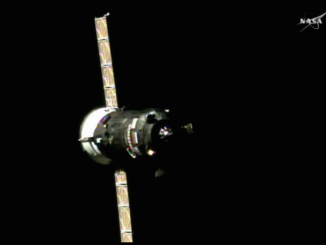
SpaceX test-fired a Falcon 9 rocket at Cape Canaveral Friday evening, igniting nine Merlin engines for several seconds while hold-down restraints kept the launcher on the ground.
The company also confirmed the rocket is scheduled for takeoff Wednesday on a space station resupply mission, three days later than previously planned.
The instantaneous launch opportunity Wednesday is set for 6:24 p.m. EDT (2224 GMT), roughly the moment Earth’s rotation brings Cape Canaveral under the International Space Station’s orbital plane.
A Dragon cargo capsule previously flown on two resupply missions to the station in April 2015 and December 2017 will ride into orbit on top of the Falcon 9 launcher. If the launch and rendezvous go according to plan, the automated supply carrier will arrive at the space station early Friday with several tons of cargo, food and experiments.
It’s the first time SpaceX has flown a Dragon capsule three times. Hans Koenigsmann, SpaceX’s vice president of build and flight reliability, said earlier this year that the first-generation Dragon spacecraft — set for retirement next year — are capable of flying up to three missions into space.
The mission next week is the 18th launch to resupply the space station under a $3.04 billion cargo transportation contract with NASA. First signed in 2008, the deal covers 20 resupply missions, and SpaceX also holds separate multibillion-dollar NASA contracts for additional supply deliveries in the early 2020s, and for the development of the Crew Dragon capsule designed to carry both cargo and astronauts.
SpaceX will return the Falcon 9 launcher to its hangar at pad 40 over the weekend for attachment of the Dragon cargo craft. The Falcon 9 set for launch Wednesday is also partially reused, with its first stage a veteran of a previous launch in May.
The Falcon 9’s first stage will return to Cape Canaveral for a rocket-assisted touchdown at Landing Zone 1 around eight minutes after liftoff Wednesday evening.
The hold-down firing occurred at 6 p.m. EDT (2200 GMT) Friday after SpaceX worked through technical issues that delayed the test from earlier in the week. SpaceX originally planned to conduct the static fire test Tuesday, and the Falcon 9 launch team loaded the rocket with propellants before apparently aborting the mock countdown.
The troubles that delayed the static fire test also forced SpaceX to push back the mission’s launch from Sunday to Wednesday.
Items slated for delivery to the station inside Dragon’s pressurized cabin include a 3D BioFabrication Facility developed by Techshot, an Indiana-based company, to demonstrate printing soft human tissue in microgravity, a capability researchers view as a stepping stone toward potentially manufacturing organs for transplant patients.
A habitat carrying 40 female mice will also launch inside SpaceX’s Dragon spacecraft. The capsule will return to Earth with 30 of the mice to Earth after approximately a month in orbit, and specimens from the mice will distributed to medical and biological researchers to investigate how spaceflight affected the animals.
The other 10 mice will remain on the station to undergo longer exposure to microgravity.

The Dragon will also deliver a new docking adapter that will be used by SpaceX and Boeing commercial crew capsules to link up with the space station.
The International Docking Adapter-3, or IDA-3, was built by Boeing to replace a unit lost during a SpaceX launch failure in 2015. SpaceX successfully delivered IDA-2 to the station in 2016, and the new docking mechanism was first used in March by SpaceX’s Crew Dragon spacecraft on an unpiloted test flight before officials clear astronauts to ride the vehicle.
The space station’s robotic arm will pull IDA-3 out of the Dragon cargo capsule’s rear payload bay and place it on the space-facing zenith port of the space station’s Harmony module, allowing Boeing’s Starliner and SpaceX’s Crew Dragon capsules to park at the station at the same time.
Email the author.
Follow Stephen Clark on Twitter: @StephenClark1.



